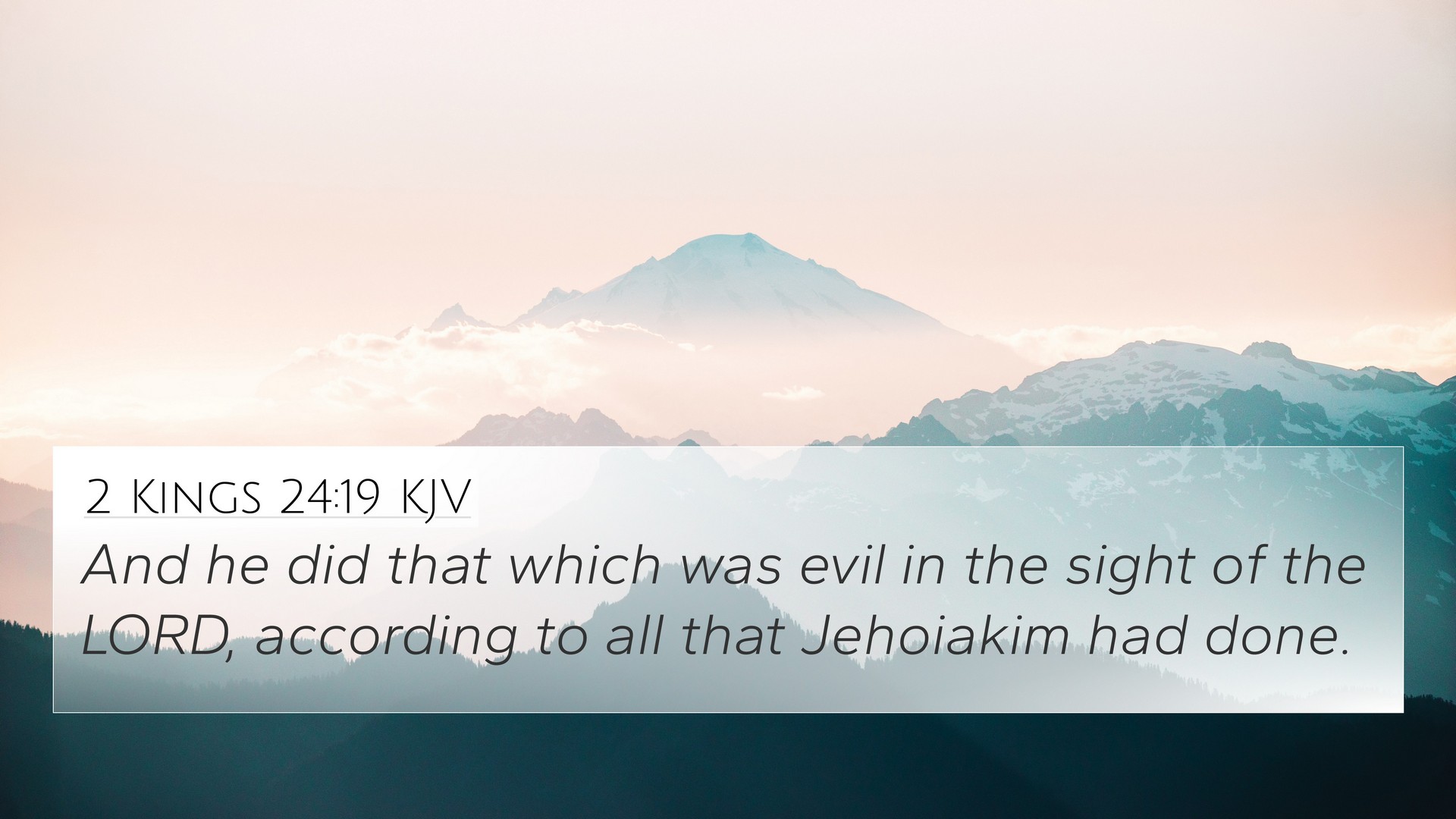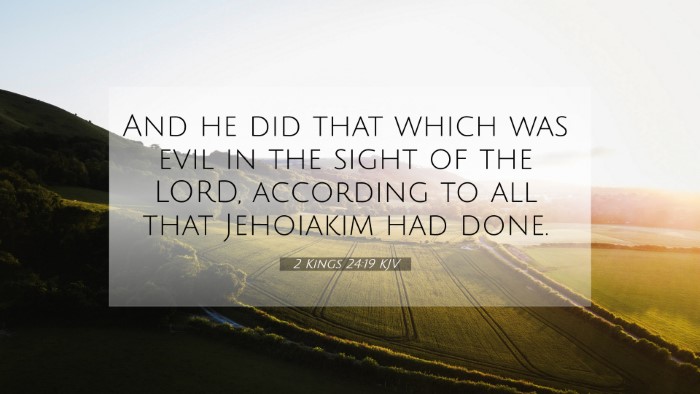Old Testament
Genesis Exodus Leviticus Numbers Deuteronomy Joshua Judges Ruth 1 Samuel 2 Samuel 1 Kings 2 Kings 1 Chronicles 2 Chronicles Ezra Nehemiah Esther Job Psalms Proverbs Ecclesiastes Song of Solomon Isaiah Jeremiah Lamentations Ezekiel Daniel Hosea Joel Amos Obadiah Jonah Micah Nahum Habakkuk Zephaniah Haggai Zechariah Malachi2 Kings 24:19 Similar Verses
2 Kings 24:19 Cross References
And he did that which was evil in the sight of the LORD, according to all that Jehoiakim had done.
Uncover the Rich Themes and Topics of This Bible Verse
Listed below are the Bible themes associated with 2 Kings 24:19. We invite you to explore each theme to gain deeper insights into the Scriptures.
2 Kings 24:19 Cross Reference Verses
This section features a detailed cross-reference designed to enrich your understanding of the Scriptures. Below, you will find carefully selected verses that echo the themes and teachings related to 2 Kings 24:19 KJV. Click on any image to explore detailed analyses of related Bible verses and uncover deeper theological insights.
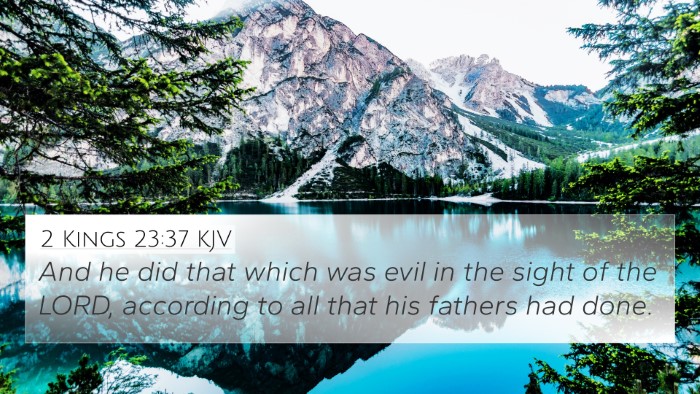
2 Kings 23:37 (KJV) »
And he did that which was evil in the sight of the LORD, according to all that his fathers had done.
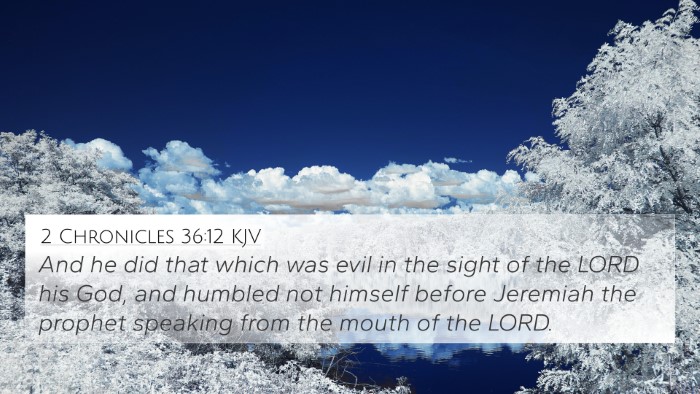
2 Chronicles 36:12 (KJV) »
And he did that which was evil in the sight of the LORD his God, and humbled not himself before Jeremiah the prophet speaking from the mouth of the LORD.
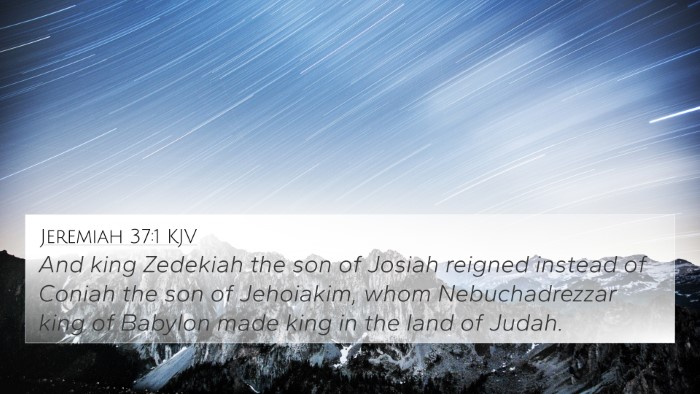
Jeremiah 37:1 (KJV) »
And king Zedekiah the son of Josiah reigned instead of Coniah the son of Jehoiakim, whom Nebuchadrezzar king of Babylon made king in the land of Judah.
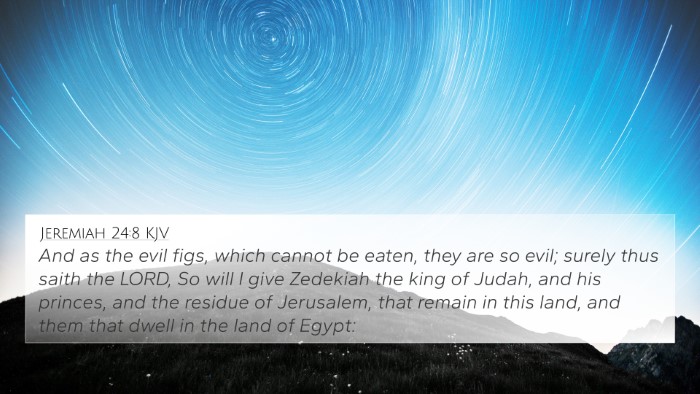
Jeremiah 24:8 (KJV) »
And as the evil figs, which cannot be eaten, they are so evil; surely thus saith the LORD, So will I give Zedekiah the king of Judah, and his princes, and the residue of Jerusalem, that remain in this land, and them that dwell in the land of Egypt:

Ezekiel 21:25 (KJV) »
And thou, profane wicked prince of Israel, whose day is come, when iniquity shall have an end,
2 Kings 24:19 Verse Analysis and Similar Verses
Understanding 2 Kings 24:19
Verse: 2 Kings 24:19 - “And he did that which was evil in the sight of the LORD, according to all that Jehoiakim had done.”
This verse, situated within the historical narrative of the Kings of Israel and Judah, serves as a significant comment on the actions of King Zedekiah of Judah. It highlights a repetitive theme throughout the Kings, where rulers are evaluated based on their faithfulness or infidelity to God.
Key Themes and Insights
- The Nature of Evil: The phrase "did that which was evil in the sight of the LORD" emphasizes the moral and spiritual decay of King Zedekiah, aligning him with his predecessor Jehoiakim, who himself was noted for leading the people away from the worship of Yahweh.
- Historical Context: This passage fits within the broader narrative of Judah's decline and eventual captivity, serving as a reminder of the consequences that arise from disobedience to divine commands.
- Divine Judgment: The reference to actions being “according to all that Jehoiakim had done” indicates a pattern of sin that not only affects the leader but also has ramifications for the entire nation.
Commentary Summary
Matthew Henry
Matthew Henry notes that Zedekiah’s evil actions are a continuation of the sins of those who ruled before him. He underlines that the kings of Judah often followed the wickedness of their forebearers, leading to a cumulative effect that resulted in divine disfavor and eventual judgment.
Albert Barnes
Albert Barnes emphasizes that Zedekiah’s evil acts are a clear reflection of his character. He discusses how the tendency to imitate previous unrighteous rulers contributed to the nation’s spiritual decline. Barnes suggests that this verse showcases the importance of leadership and its impact on national morality and faithfulness.
Adam Clarke
Adam Clarke provides an analysis of the implications of this verse for the purpose of understanding the covenant between God and Israel. He argues that Zedekiah’s failure represents a breach of covenant, which ultimately leads to God’s judgment as prophesied in earlier texts.
Cross-References and Connections
The verse connects with a variety of other scriptural passages to emphasize its thematic elements:
- 2 Kings 21:2: Describes Manasseh's evil reign which sets a precedent for subsequent kings.
- Jeremiah 34:1-3: Discusses Zedekiah’s reign and his eventual downfall due to disobedience.
- 2 Chronicles 36:12: Highlights that Zedekiah did evil in the Lord’s sight.
- Isaiah 39:5-7: Foretells consequences of Judah's sinfulness during Zedekiah’s reign.
- Lamentations 1:8: Reflects on the desolation of Jerusalem as a result of its leaders' actions.
- 2 Kings 24:14: Discusses the exile resulting from the collective sins of the leadership.
- Deuteronomy 28:15: Lists the consequences of failing to follow God's commandments.
- Exodus 34:7: References the idea of iniquity affecting generations, showcasing divine justice.
- Proverbs 28:2: Illustrates that a nation’s sinfulness causes instability in governance.
- Romans 1:21: Connects to the theme of disregard for God and the resulting moral decline.
Bible Verse Parallels and Thematic Connections
As we explore 2 Kings 24:19, it is essential to recognize how the themes presented are not isolated but rather echo throughout the biblical narrative. The consistent pattern of leadership failure, divine judgment, and the covenantal relationship showcases an inter-Biblical dialogue that invites further study:
- Leadership and Responsibility: Throughout the scriptures, leaders are held accountable for the spiritual state of their people, as seen in 1 Samuel 15:23.
- Covenant Breakers: The motif of covenant unfaithfulness spans many books of the Old Testament, with warnings and consequences articulated in Jeremiah.
- Divine Justice: The principle that evil acts lead to judgment is firmly established in Proverbs and echoed in the New Testament, particularly in Galatians 6:7.
Tools for Bible Cross-Referencing
For further exploration of connections between Bible verses, using effective tools for Bible cross-referencing can enhance understanding:
- Bible Concordance: A critical tool that allows for easy location of verses related by themes, words, or concepts.
- Cross-Reference Bible Study: Techniques for linking biblical texts yield insights into broader meanings and applications.
- Bible Reference Resources: Materials such as study Bibles often contain helpful annotations indicating related verses.
Conclusion
2 Kings 24:19 stands as a testament to the cyclical nature of sin and leadership within the biblical narrative. By engaging with this verse and its surrounding contexts through cross-referencing, readers can gain a deeper understanding of God’s enduring principles regarding obedience and judgment. The interconnectedness of scripture invites believers to reflect both on historical transgressions and their own lives today.
Further Study Suggestions
- Explore how themes of leadership and morality are portrayed in the Gospels.
- Investigate the concept of covenant in-depth through studies in the Pentateuch.
- Utilize strong Bible cross-reference systems to identify thematic links between Old and New Testament scripture.
